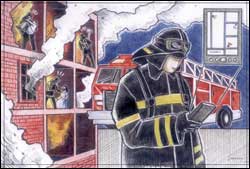’Smart’ buildings to guide future first responders

"Intelligent" building systems may someday allow firefighters and other first responders to better respond to emergencies by providing information such as building floor plans and real-time data from motion, heat, biochemical and other sensors and video cameras.
The best response to a building emergency is a fast and informed one. The National Institute of Standards and Technology (NIST) is working with the building industry as well as the public safety and information technology communities to achieve both objectives.
NIST researchers are studying how “intelligent” building systems can be used by firefighters, police and other first responders to accurately assess emergency conditions in real-time. One of the biggest problems faced by first responders is a lack of accurate information. Where is the fire within the building? How big is it? Are there flammable chemicals stored nearby?
NIST is working with industry to develop standards to allow manufacturers to create intelligent building systems that use various types of communication networks (including wireless networks) to assist first responders in assessing and mitigating emergencies. The systems would send information such as building floor plans and data from motion, heat, biochemical and other sensors and video cameras directly to fire and police dispatchers who then can communicate detailed information about the scene to first responders.
NIST recently released video presentations that demonstrate how an “Intelligent Building Response” program would work. The videos outline team efforts to create a system of interoperable data content and communications standards that would link first responders with “intelligent” building systems. Firefighters are shown using laptops to track the spread of a developing fire on a floor plan even before reaching the scene. Other real-time building sensor information includes status information concerning a specific building’s mechanical systems, elevators, lighting, security system and fire systems, the locations of building occupants, and temperature and smoke conditions.
Media Contact
All latest news from the category: Architecture and Construction
Newest articles

Sea slugs inspire highly stretchable biomedical sensor
USC Viterbi School of Engineering researcher Hangbo Zhao presents findings on highly stretchable and customizable microneedles for application in fields including neuroscience, tissue engineering, and wearable bioelectronics. The revolution in…

Twisting and binding matter waves with photons in a cavity
Precisely measuring the energy states of individual atoms has been a historical challenge for physicists due to atomic recoil. When an atom interacts with a photon, the atom “recoils” in…

Nanotubes, nanoparticles, and antibodies detect tiny amounts of fentanyl
New sensor is six orders of magnitude more sensitive than the next best thing. A research team at Pitt led by Alexander Star, a chemistry professor in the Kenneth P. Dietrich…





















